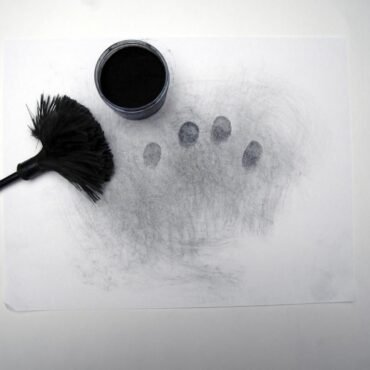
Certified Digital Forensics Examiner (CDFE)
1. Introduction – What is Certified Digital Forensics Examiner (CDFE)? The Certified Digital Forensics Examiner (CDFE) course by Mile2 is one of the most respected certifications in the field of ...


Fingerprint Examination Ayushi Agrawal todayOctober 7, 2025

In the realm of forensic science, fingerprint analysis has long been regarded as one of the most reliable methods of personal identification. The uniqueness and permanence of fingerprint patterns form the backbone of this technique, making it invaluable in criminal investigations, civil disputes, and personal authentication systems. While ridge patterns and minutiae points (ridge endings, bifurcations, etc.) are commonly used for identification, forensic experts also rely on more microscopic features such as pores. The study of sweat pores for identification is known as poroscopy.
Poroscopy offers an additional layer of accuracy, especially in cases where only partial, distorted, or smudged fingerprints are available. By examining the number, shape, size, and relative position of pores along the friction ridges, forensic experts can confirm an individual’s identity with remarkable precision.
Poroscopy is the microscopic study of sweat pores present on the ridges of fingerprints. Introduced in 1912 by Edmond Locard, the “Father of Modern Criminalistics,” poroscopy was developed to strengthen fingerprint evidence in cases where ridge details were insufficient for conclusive identification.
Sweat pores are tiny openings of the sweat glands located along the ridge lines of the finger. These pores are:
Unique – The arrangement of pores varies from individual to individual.
Permanent – Once formed, their structure does not change throughout a person’s life.
Individually Characteristic – Even identical twins, who share the same DNA, have distinct pore structures.
Thus, poroscopy provides an added dimension to the science of dactyloscopy (fingerprint study).
Poroscopic examination involves a detailed study of the following characteristics:
Shape of Pores
Pores may appear round, oval, square, triangular, or irregular. The variation itself becomes a basis for comparison.
Size of Pores
Some pores are larger or more elongated than others, and their comparative size can be a distinguishing factor.
Position of Pores
The relative placement of pores on a ridge is one of the most critical factors in poroscopy. No two individuals have the same pore arrangement.
Number of Pores per Ridge Unit
The density of pores can vary from ridge to ridge. Counting pores between two ridge features can help in individualisation.
Poroscopy is especially significant in cases where traditional ridge pattern examination is insufficient. Here’s why it matters in forensic science:
Enhances Reliability of Fingerprint Evidence
Even when ridge details are faint or unclear, pore characteristics can still be visible. Their unique patterns add another dimension to fingerprint analysis, strengthening the reliability of forensic identification.
Crucial in Partial Prints
Criminals often leave behind partial fingerprints on crime scenes, which may not display enough ridge characteristics for comparison. In such cases, pores provide an additional set of individualising features.
Resists Alteration
Unlike ridge patterns that can sometimes be deliberately altered by scars or injuries, sweat pores are difficult to manipulate. This makes them a dependable trait for identification.
Support in the Court of Law
Poroscopic evidence has been accepted in several legal cases worldwide, especially when ridge details were insufficient but pore comparison led to a positive identification.
Poroscopy has diverse applications in forensic science, especially in scenarios where traditional ridge pattern analysis may fall short. Some of the key applications are:
In many crime scenes, investigators recover only small or incomplete portions of fingerprints.
When ridge characteristics are insufficient, pore details can provide the necessary identifiers.
Prints left on uneven or porous surfaces often appear smudged.
Even in such cases, pores may remain visible, allowing forensic experts to establish identity.
Fingerprints exposed to environmental factors like heat, dust, or moisture may lose clarity.
Pore characteristics often remain intact longer, serving as reliable evidence.
In high-profile cases, poroscopy is used to strengthen fingerprint evidence by cross-verifying pore structures.
Modern AFIS technology increasingly incorporates pore-level features, enhancing its precision.
The use of poroscopy in fingerprint analysis follows a systematic process:
Collection of Fingerprint Evidence
Latent fingerprints are collected from the crime scene using powders, chemical developers, or alternate light sources.
Magnification and Imaging
High-resolution photography, comparison microscopes, and digital imaging tools are used to magnify the fingerprint ridges and pores for detailed observation.
Comparison with Known Prints
The suspect’s fingerprints are taken under controlled conditions and compared with the questioned print. The expert focuses on both ridge characteristics and pore details.
Documentation and Reporting
Findings are documented with photographic evidence and expert notes, which can later be presented in court.
Increases Accuracy: Provides additional points of comparison beyond ridge features.
Helps with Faint Prints: Useful when latent fingerprints are smudged or incomplete.
Difficult to Forge: Sweat pore characteristics cannot be easily reproduced or disguised.
Stability Over Time: Pores remain consistent throughout life, making them reliable markers of identity.
Despite its advantages, poroscopy is not without limitations:
Quality of Latent Prints – Clear pore details require high-quality impressions. Smudged or low-resolution prints may hinder analysis.
Time-Consuming – Manual pore-by-pore analysis can be tedious.
Subjectivity – Interpretation of pore features may vary among experts without standardised guidelines.
Technological Dependence – Advanced imaging tools are necessary for accurate examination.
Because of these challenges, poroscopy is often used as supportive evidence rather than a standalone method.
Poroscopy has played a significant role in multiple forensic cases worldwide. Some applications include:
Criminal Investigations
Burglary, homicide, and assault cases often rely on partial or smudged fingerprints. Poroscopy has helped establish the presence of suspects at crime scenes when ridge details were insufficient.
Verification of Identity
In civil cases, poroscopy has been used to verify the authenticity of fingerprints in disputed documents.
Cold Case Resolution
With advancements in imaging technology, old fingerprint evidence can be re-examined for pore details, breathing new life into previously unresolved cases.
With advancements in technology, poroscopy is gaining greater importance in modern forensic science. Some future directions include:
Integration with AFIS – Automated systems are being upgraded to analyse pore-level details, improving match accuracy.
3D Fingerprint Imaging – High-resolution 3D imaging may provide even clearer visualisation of pore structures.
Artificial Intelligence (AI) Applications – AI-driven algorithms could reduce subjectivity by standardising pore analysis.
Forensic Research – Continued research is expanding the understanding of pore variability across populations.
Poroscopy represents a powerful tool in the forensic toolkit, enhancing the accuracy and reliability of fingerprint identification. By focusing on microscopic features like pore size, shape, and position, forensic experts can establish identity even in challenging scenarios where ridge details are incomplete or unclear.
Though it faces challenges such as subjectivity and technological dependency, poroscopy remains an invaluable supplementary method in fingerprint analysis. With ongoing technological advancements, the future promises greater integration of poroscopy into automated identification systems, ensuring that justice continues to rely on science at its most detailed level.
Written by: Ayushi Agrawal
Tagged as: ForensicScience, DigitalForensics, #HawkEyeForensic, Poroscopy, Fingerprint Identification, JusticeThroughScience.

Blog Omprakash Singh
1. Introduction – What is Certified Digital Forensics Examiner (CDFE)? The Certified Digital Forensics Examiner (CDFE) course by Mile2 is one of the most respected certifications in the field of ...


Copyright 2016-2025 all rights reserved by Hawk Eye Forensic.
Post comments (0)